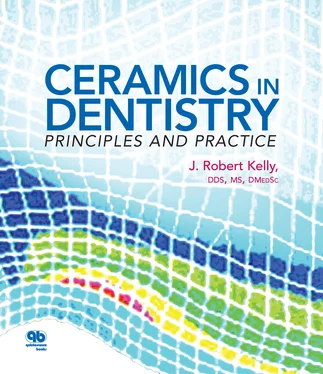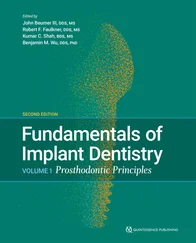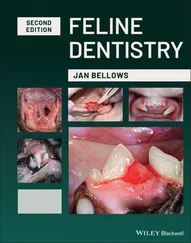Ceramics in Dentistry: Principles and Practice
CERAMICS IN
DENTISTRY
PRINCIPLES AND PRACTICE
J. Robert Kelly, DDS, MS, DMedSc
Professor, Department of Reconstructive Sciences
Center for Biomaterials
University of Connecticut Health Center
Farmington, Connecticut

Library of Congress Cataloging-in-Publication Data
Names: Kelly, J. Robert, 1952- , author.
Title: Ceramics in dentistry : principles and practice / J. Robert Kelly.
Description: Hanover Park, IL : Quintessence Publishing Co, Inc, [2016] |
Includes bibliographical references and index.
Identifiers: LCCN 2015041374 | ISBN 9780867156539 (softcover) | eISBN 9780867157277
Subjects: | MESH: Dental Porcelain. | Computer-Aided Design.
Classification: LCC RK655 | NLM WU 190 | DDC 617.6/95--dc23
LC record available at http://lccn.loc.gov/2015041374

© 2016 Quintessence Publishing Co, Inc
Quintessence Publishing Co, Inc
4350 Chandler Drive
Hanover Park, IL 60133
www.quintpub.com
5 4 3 2 1
All rights reserved. This book or any part thereof may not be reproduced, stored in a retrieval system, or transmitted in any form or by any means, electronic, mechanical, photocopying, or otherwise, without prior written permission of the publisher.
Editor: Leah Huffman
Cover design: Ted Pereda
Production: Angelina Sanchez
Contents
Preface
1Introduction to Ceramics in Dentistry—Where Did This Stuff Come From?
2Ceramics 101: What Is This Stuff Anyway?
3Indications for All-Ceramic Systems Based on Clinical Evidence
4Engineering with Ceramics: Maximizing Durability and Esthetics
5Processing of Ceramic Restorations and Prostheses
6Getting It Right: Basic Requirements for an Esthetically Successful Outcome
7Structural Ceramics in Implant Dentistry
 |
| Additional Content Extra content, including videos, lectures, and other animations, is available online. Thumbnail images in the margins of the text introduce this additional material. Scan the QR code to access this supplementary information. The full list of links may also be found at www.quintpub.com/CeramicsInDentistry. |
Preface
Welcome to the “Kelly Lectures on Ceramics”—aimed at general dentists, prosthodontists, high-end laboratory technicians, and prostho-cadets—meant to harken back to the Feynman Lectures on Physics. (Alas, I do not play bongo drums like he did.) This book is designed to teach what this stuff is, what it is good for (from clinical data), and how to maximize durability and esthetics.
Before I headed off to Harvard to study prosthodontics and MIT as a cross-registration student studying glass science and ceramic engineering, I knew that I faced a pivotal career choice: to focus my doctoral work on either resin-based composites or ceramics. I had been introduced to both along with metallurgy and mechanics in my superb materials masters degree program mentored by Bill Brantley at Marquette University. Obviously ceramics won, in part due to inspiration from the two-volume series on the art and science of dental ceramics by Dr John McLean (Quintessence, 1979). At that time my interest in all-ceramic systems and high-end esthetics was warming up.
In Boston, Ted Riley and Ralph Sozio, working with Coors Biomedical, had introduced the first net-shape (ie, nonshrinking) ceramic to dentistry along with the first “high technology” ceramics processing equipment into the dental laboratory. Shortly thereafter, David Grossman from Corning Glass Works, working in partnership with Dentsply, introduced Dicor, the first glass-ceramic dental material. Also in Boston, Kenneth Malament was just beginning his phenomenal in-depth clinical study of many aspects of all-ceramic prostheses. About this time, my MIT professor, Kent Bowen, received a letter from Dr Werner Mörmann, the inventor of the CEREC machine, wanting a better ceramic. It was my job to write the answer and to host Werner at the MIT Ceramics Processing Research Laboratory. Next to visit was Henry Rauter, owner of Vita Zahnfabrik, along with Wayne Whitehill, President of Vident. With the sponsorship of Vita and working closely with their top inorganic chemist, Norbert Thiel, we invented the Vita Mark II block for CEREC—still a high-technology material on today’s market with wonderful wear kindness (trade secret). In the meantime, I attended the first CEREC course taught in English (at the University of Zurich) and learned to appreciate flying to Europe in business class!
Over the years I have developed quite some teaching material on dental ceramics, including organizational approaches; simplified concepts of strength, toughness, and durability; and even a new classification system used in the international dental standard, ISO 6872. Many, many lecture opportunities presented themselves, and slowly I came to have sufficient material to fill all-day programs—and now a book.
My wife has been encouraging me to write a book for years. I found that as I sat down to put keyboard to paper, I was simply lecturing through my fingertips with the wonderful opportunity to expand the content. Even more exciting was the idea to use either scannable codes or links to allow interested readers to sample extra visual content that is both humorous and informative. And best yet, the folks at Quintessence liked the idea (although Lisa Bywaters once suggested my appearing as a cartoon character). Thus, this book has the potential to be a “living book” as we can add to and enhance the linked content.
Acknowledgments
Key individuals helped in providing encouragement and proofreading of the manuscript, including Drs Werner Mörmann of Zurich, Switzerland, and David Burnham of Edmonton, Canada. And, of course, thanks Patrice for the gentle wifely push !
1
Introduction to Ceramics in Dentistry—Where Did This Stuff Come From?
Craft Art or High Technology
When I have the opportunity to lecture on the history of ceramics in dentistry, I enjoy challenging audiences to commit by a raise of hands as to whether they think dentistry borrowed ceramic technology from craft art or pursued it through innovation and high technology. To further develop the point, I draw a clear distinction between high technology and craft art by providing some defining characteristics of each. Many would agree that high technology should include: (1) dentistry borrowing materials/processes shortly after their development by an unrelated industry, (2) incorporation of new learning from recent scientific literature outside of dental medicine, and (3) the spread of outright new inventions within dentistry. Craft art , on the other hand, brings to mind materials and techniques borrowed from highly skilled artisans involved in jewelry making, the arts, and the manufacture of everyday goods. More than 90% of people vote for an origination through craft art, as I would have done prior to my literature search!
Читать дальше















